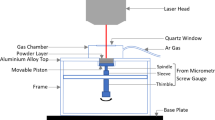Abstract
A three-dimensional (3D) selective laser melting (SLM) model comprising coupled heat transfer and flow behavior is proposed. The free surface of the melt pool is calculated by the volume-of-fluid (VOF) method, which is a means of acquiring the surface morphology. In this research, laser powers and laser scanning speeds were normalized to characterize the influence on the surface morphology. Results showed that when the scanning speed was increased, the surface morphology initially became flatter, but then roughness developed again at high speed case. Further, as the laser power was increased, the surface morphology gradually roughened. To better describe the surface-morphology phenomenon according to different laser parameters, the melt pool volume and melt pool lifetime were also investigated. With these two factors constrained, a fine surface could be obtained with a low melt pool volume and proper lifetime (approximately 100 to 130 μs). The surface morphology and the width of the melt track were experimentally acquired, and are in a good agreement with the results predicted by simulation.











Similar content being viewed by others
References
Kruth JP, Levy G, Klocke F, Childs THC (2007) Consolidation phenomena in laser and powder-bed based layered manufacturing. CIRP Ann Manuf Technol 56(2):730–759. https://doi.org/10.1016/j.cirp.2007.10.004
DD G, Meiners W, Wissenbach K, Poprawe R (2012) Laser additive manufacturing of metallic components: materials, processes and mechanisms. Int Mater Rev 57(3):133–164. https://doi.org/10.1179/1743280411Y.0000000014
Zhang B, Liao H, Coddet C (2012) Effects of processing parameters on properties of selective laser melting mg–9%al powder mixture. Mater Des 34:753–758. https://doi.org/10.1016/j.matdes.2011.06.061
Zhang B, Dembinski L, Coddet C (2013) The study of the laser parameters and environment variables effect on mechanical properties of high compact parts elaborated by selective laser melting 316L powder. Mater Sci Eng A 584:21–31. https://doi.org/10.1016/j.msea.2013.06.055
Kruth JP, Mercelis P, Vaerenbergh JV, Froyen L, Rombouts M (2005) Binding mechanisms in selective laser sintering and selective laser melting. Rapid Prototyp J 11(1):26–36. https://doi.org/10.1108/13552540510573365
Kumar SS, Bai VS, Rajasekharan T (2008) Aluminium matrix composites by pressureless infiltration: the metallurgical and physical properties. J Phys D Appl Phys 41(10):105403. https://doi.org/10.1088/0022-3727/41/10/105403
Buchbinder D, Schleifenbaum H, Heidrich S, Meiners W, Bültmann J (2011) High power selective laser melting (HP SLM) of aluminum parts. Phys Procedia 12:271–278. https://doi.org/10.1016/j.phpro.2011.03.035
Dai K, Shaw L (2005) Finite element analysis of the effect of volume shrinkage during laser densification. Acta Mater 53(18):4743–4754. https://doi.org/10.1016/j.actamat.2005.06.014
Jamshidinia M, Kong F, Kovacevic R (2013) Numerical modeling of heat distribution in the electron beam melting® of Ti-6Al-4V. J Manuf Sci Eng 135(6):061010–061014. https://doi.org/10.1115/1.4025746
Gürtler FJ, Karg M, Leitz KH, Schmidt M (2013) Simulation of laser beam melting of steel powders using the three-dimensional volume of fluid method. Phys Procedia 41:881–886. https://doi.org/10.1016/j.phpro.2013.03.162
Yadroitsev I, Bertrand P, Smurov I (2007) Parametric analysis of the selective laser melting process. Appl Surf Sci 253(19):8064–8069. https://doi.org/10.1016/j.apsusc.2007.02.088
Guanqun Y, Dongdong G, Donghua D, Mujian X, Chenglong M, Qimin S (2016) On the role of processing parameters in thermal behavior, surface morphology and accuracy during laser 3D printing of aluminum alloy. J Phys D Appl Phys 49(13):135501
Dai D, Gu D (2015) Tailoring surface quality through mass and momentum transfer modeling using a volume of fluid method in selective laser melting of TiC/AlSi10Mg powder. Int J Mach Tools Manuf 88:95–107. https://doi.org/10.1016/j.ijmachtools.2014.09.010
Li Y, Gu D (2014) Parametric analysis of thermal behavior during selective laser melting additive manufacturing of aluminum alloy powder. Mater Des 63:856–867. https://doi.org/10.1016/j.matdes.2014.07.006
Hirt CW, Nichols BD (1981) Volume of fluid (VOF) method for the dynamics of free boundaries. J Comput Phys 39(1):201–225. https://doi.org/10.1016/0021-9991(81)90145-5
Mills KC (2002) Recommended values of thermophysical properties for selected commercial alloys. A volume in Woodhead Publishing Series in Metals and Surface Engineering, pp 211–217. https://doi.org/10.1533/9781845690144.211
Ma C, Chen L, Xu J, Zhao J, Li X (2015) Control of fluid dynamics by nanoparticles in laser melting. J Appl Phys 117(11):114901. https://doi.org/10.1063/1.4915276
Acknowledgements
This study is supported by the Ministry of Science and Technology (MOST 106-2218-E-006-006-), which is gratefully acknowledged.
Author information
Authors and Affiliations
Corresponding author
Ethics declarations
Conflict of interest
None.
Rights and permissions
About this article
Cite this article
Wu, YC., Hwang, WS., San, CH. et al. Parametric study of surface morphology for selective laser melting on Ti6Al4V powder bed with numerical and experimental methods. Int J Mater Form 11, 807–813 (2018). https://doi.org/10.1007/s12289-017-1391-2
Received:
Accepted:
Published:
Issue Date:
DOI: https://doi.org/10.1007/s12289-017-1391-2



